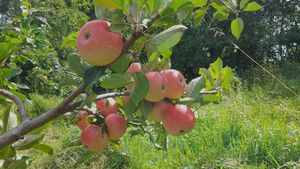Autumn days and Mother’s apple tart

Gathering apples was a troublesome job, fraught with many perils. Picture: Pat McCarrick
I can’t believe that autumn is almost upon us. Reminders are everywhere; the spider's web brought to sparkling life after a morning fog, waving Harvest Gold, the flower of old houses, and swallows, like tiny jet planes, lining up for take-off.
Autumn is a comforting season; the work of the summer is over and yet the harshness of winter is still some way off. One can afford to relax for a while, in preparation for what seems like a second New Year; a chance to draw breath and maybe choose a fresh approach.
Joseph Gale, writing for (2009), explains a little bit about the origins of Earth and our movement in relation to the sun.
Earth orbits the Sun at an average distance of 149.60 million kilometres (km) in a counterclockwise direction as viewed from above the Northern Hemisphere. One complete orbit takes 365.256 days, during which time Earth has travelled 940 million km. Phil Plait is an astronomer and author who writes for . In a blog from 2011, , Plait gives some insight into our journey through space.
Because of Earth's axial tilt, the inclination of the sun's trajectory in the sky varies over the course of the year. When the North Pole is tilted toward the sun the day lasts longer with warmer average temperatures. When the North Pole is tilted away from the sun, the reverse is true and the weather is generally cooler. This variation in the weather results in the seasons.
Palouse Colony Farm, owned and operated by Palouse Heritage, is located in the Pacific Northwest's Palouse Country, an area fabled for the fertility of its undulating landscapes. In a post on their beautiful website, (2017), Palouse Heritage takes us right back to ancient times and ends up explaining the importance mankind of the humble sickle.
My memories of autumn and harvest time centres around saving oats and picking apples. Saving oats was a happy memory but picking apples brings to mind a time of nettle stings and tummy pains.
After the lengthy campaign of hay-making throughout the summer, a day in the oats fields was a welcome relief. The project had a novelty aspect to it and presented a reluctant child with a lot of variety. For a start, the crop of oats was just about an acre in size so, if the day was favourable, the task of felling the crop, tying it in sheaves, and stooking it, could be completed in a few good hours.
Whatever the sickle may have done for the growth of mankind, our oats crop was cut by a Ferguson 35 trailing a finger bar mower. The mower had its grass board removed for this manoeuvre, so as not to overlap the sward of felled oats. This made the oats, now lying on the ground, easier to lift by hand. A speedy oats harvesting job relied on a few handy people ‘lifting’ and tying sheaves. Sheaves needed to be neat and of a consistent size.
Come evening, the acre was in stooks. The stooks were protected from late August rain by being ‘thatched’ by two head sheaves, which was basically upside-down sheaves tied tightly at the top of the stook. In such a state, the stooks could be left on the stubble for a week or ten days or until such time as another promising day allowed them to be aired and stacked.
My maternal grandfather had an apple orchard. In his day, he had many varieties of apples ranging from cookers to eating apples. This man took a great interest in all thing agricultural and horticultural and his orchard was his pride and joy. My mother loved this exotic collection of fruit trees and each autumn she would dispatch us to her homeplace, about three miles away, to collect apples.
By the time I came of age to be sent for apples, my grandfather had passed away and his orchard was overgrown. The trees there still produced fruit, albeit less bountifully than of old. Gathering apples was a troublesome job, fraught with many perils. Our cousins lived much closed to the orchard and as a result they had availed themselves of the low hanging fruit. This meant that the only apples available to me, in my short trousers, were those windfalls strewn among the nettles. I lie; there were others, on the highest jungle canopy. Getting to those however meant climbing slippery, moss-covered boughs at great risk to myself while offering little by way of reward.
Cycling home, with a string shopping bag full of apples hanging from the handlebars, was no easy task either and nettle-stung legs and the tummy ache being brought on by having consumed one too many green apples didn’t help. What did make things better was my mother’s gratitude. She was so delighted to be getting apples from her father’s orchard, even after he was dead and gone.
My mother’s apple tarts were delicious. I have seen some that have come close but none equalled. Her speciality was a very large tart that she made on a cast iron handleless pan. Her pastry was bready but light and she fairly lashed in the apples… and the sugar.
The whole lot was baked in the oven of our old Stanley 8, and as the apples and the sugar boiled up inside the pastry, they oozed out forming a sticky, toasty, sugary boundary between the outer edge of the tart and the inner rim of the pan. Suddenly, the nettle stings were gone and the fearful feelings generated by climbing those overgrown apple trees made the risk perfectly worthwhile.





